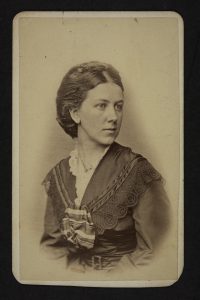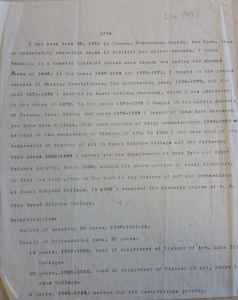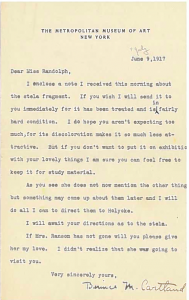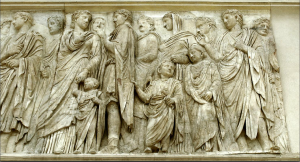Louise Fitz Randolph: Pioneer Beyond the Gates
Louise Fitz Randolph is remembered today at Mount Holyoke College as a pioneer in the Art History Department and for spearheading the development of the art museum to what it is today. Fitz Randolph’s contributions to the collection were not from excavations, but rather due to her own passionate purchases of plaster casts of European, Roman, and Egyptian art.

Fitz Randolph attended Mount Holyoke and graduated in 1872, only to return twenty years later as a professor, leading the Department of Art and Department of Archaeology and History of Art.1
Before her time at the college as a professor, she had not only taught in various schools, but had also traveled the world, a feat that was inspirational to many students and colleagues.
Childhood and Mount Holyoke College

On June 25th 1851, Louise Fitz Randolph was born to Julia Bell and Reuben F. Randolph in Panama, New York. According to her short autobiography, she began her career as a teacher near her home in 1866 and moved to teach at schools in Sharon, Pennsylvania.2 After graduating from the college in 1872, which was originally established by Mary Lyon as Mount Holyoke Seminary in 1837, she taught at public schools in Toledo, Ohio, and spent twenty years, 1876 to 1896, teaching at Lake Erie Seminary, which was renamed Lake Erie College and modelled after Mount Holyoke.3
Fitz Randolph’s personal education did not stop at Mount Holyoke College. After having the honor of graduating in the newly established History of Art department, she continued her studies at Harvard Annex, Boston University, University of Chicago, and Columbia University from 1880 to 1906.4 Mount Holyoke was a pioneer at the time by offering courses in art, which only happened at one other school, Harvard University.5 Her studies were not limited to the United States, however—she spent many years abroad in Europe, studying at Oxford University, South Kensington and British Museums in London, Sorbonne and École des Beaux Arts in Paris, University of Berlin, University of Zürich, and American Schools of Classical Studies at Athens and Rome.6 The time she spent in France must have been productive, as she later writes letters in French to correspondents in Paris and even gives references to people in Paris to purchase objects for Mount Holyoke College.7
Professor at Lake Erie and Mount Holyoke

Fitz Randolph officially joined the college in 1892 but continued to spend time at Lake Erie College before devoting herself entirely to Mount Holyoke. She is the sole reason for the creation of Dwight Hall as a gallery for art 8, and after retiring she continued to spend her time and energy developing the art museum, making various global purchases and inspiring her colleagues to use visual resources to better educate their students. Martha S. H. Cowles wrote for Mount Holyoke Alumnae Quarterly after the death of Fitz Randolph stating that “fortunate undergraduates at Lake Erie College and Mount Holyoke College” had the opportunity to learn from her and absorb in her “intimate knowledge and appreciation” of “sculptures of the archaic period in Greece, the development of cathedral architecture or the study of Italian Primitives.”9
Passion for Art History
Fitz Randolph reminisced about her time at Mount Holyoke, writing about Miss Mary Ellis, the one person who seems to have incited Fitz Randolph’s interest in art history.10 Fitz Randolph took part in a six-week course offered by Ellis during which she had the opportunity to study Greek and Gothic architecture. The opening of Durant Library on top of photographs and reproductions 11 brought over from Europe by Ellis for her class were sensational. She described this experience as something that led her to be “fired with a purpose to know more about all this marvelous world of art.”12 Though the course was discontinued and Ellis left the college, Fitz Randolph wrote passionately about Ellis’ contribution to the department and Mount Holyoke in general:
“In 1889 she [Ellis] enlisted the alumnae to unite in making the college a member of The Archaeological Institute of America, founded only two years previously by Charles Eliot Norton. Mount Holyoke was thus, after Vassar, the first woman’s college represented in the Institute.”13
It would not be an exaggeration to state, therefore, that Fitz Randolph’s passion for art history and contributions to the college would not have happened had it not been for Ellis and her courses of 1872.
Correspondences and their Beginnings

Continuing her passion for art history, Fitz Randolph became a professor of art history and immersed herself in expanding not only the department, but also the museum collection. The beginnings of collecting art are chronicled in extensive correspondence exchanged with individuals in Europe and elsewhere. Fitz Randolph’s main reason for starting a collection at Mount Holyoke was for educational purposes, though she made personal purchases as well for her own collection. She saw value in teaching students with physical objects that could be touched; hence her interest grew in purchasing plaster casts, which remain displayed in the college’s Art Building. Many have been lost, vandalized, or given away, and the remaining were not initially well protected. However, as the value in plaster casts has grown in the past couple of years, the museum has assumed oversight of their care.
Letters from Esther Van Deman
Esther Van Deman was a professor at Mount Holyoke College from 1898 to 1901, during which time she befriended Fitz Randolph. When Van Deman left for the American School of Classical Studies in Rome, the two remained in contact; Van Deman was one of Fitz Randolph’s key correspondents in Europe who helped her not only find people to craft the plaster casts, but also who purchased and had them shipped to the college. 14
In a letter written from Van Deman in Rome to Fitz Randolph on December 16th, 1907, she chronicled her hardships in finding prices for plaster casts on Fitz Randolph’s purchase-list. She wrote, “Finally, I have found the prices of the casts; -I am much ashamed of myself- but it was not all my delay, for I have been hunting down various people for almost a month, in all my spare moments.” 15 It is already clear from this opening sentence the amount of time and effort spent on behalf of Fitz Randolph by Van Deman for the college and its art collection. In addition to her own studies and excavation experiences in Rome, Van Deman was investing an extensive amount of time into fulfilling the wishes of Fitz Randolph.
The first work mentioned in Fitz Randolph’s list of plaster casts for Dwight Hall, sent to Van Deman in Rome, was the Roman Altar of Augustan Peace, the Ara Pacis. In her letter, however, the section that Fitz Randolph wanted was unavailable as a plaster cast; if the college wished to go forth with purchasing a reproduction it would have to be reproduced from scratch under strict governmental restrictions. 16 At Mount Holyoke today, the cast of the relief (seen below) that is displayed in the stairwell of the Art Building does not seem to be the one requested in the list sent to Van Deman.

Van Deman also wrote, “The Beneventum reliefs can be had at the enclosed prices. The same man makes a bid for the other two statues.” 17 These reliefs do not exist at Mount Holyoke so although there are no followup letters written to be found regarding the destiny of these reliefs, it is most likely that financial constraints kept the college from being able to purchase them for its collection.
Van Deman expressed her apologies at the prices of the plaster casts but she found them reasonable for the size and quality of the pieces. Fitz Randolph gave her $300 to purchase 12 plaster casts, which was not sufficient.
Next Letter from Van Deman
The next letter written by Van Deman to Fitz Randolph was on January 31st, 1908 in Rome, Italy. The letter shows how the list of plaster casts from the previous letter became significantly shorter. It can be implied from Van Deman’s letter that the reason was not purely financial, but also because of a particular plaster-cast master that both Van Deman and Fitz Randolph trusted and wanted their plaster casts to be made by. However, there seemed to have been some confusion around payment for these plaster casts. Van Deman wrote, “I do not know the rule about paying. When accepted satisfactory, I do not know if a part is to be paid or whether you will be allowed to see them unpacked in America.” 18
This particular part of the correspondence is important because it illustrates how both women were not experts in this area, but were driven purely by their passion for art to fervently pursue plaster casts for Mount Holyoke. The letter also details how Van Deman was in a tight financial situation both because of trying to help Fitz Randolph with the purchases and helping an American friend who was struggling financially; the bonds between these women were strong.
Louise Fitz Randolph to Louise Rogers Jewett
It is surprisingly difficult to find letters written by Fitz Randolph to her correspondents, which poses the challenge of knowing how Fitz Randolph felt about certain situations or how she would have liked to deal with certain obstacles. However, in one letter written to Louise Rogers Jewett, who was the author of a book, Masterpieces of Painting Their Qualities and Meanings, an Introductory Study, she confided about an artwork, “Meidoum Geese.” 18 Louise Rogers Jewett was a professor at Mount Holyoke during the same years as Randolph and taught in the Art Department. 20 This means that they were most likely colleagues and had discussed in great lengths what needed to be achieved in order to grow the department and the collection at Dwight Hall, which Fitz Randolph mentioned in the letter. She intended for “Meidoum Geese” to be part of its exhibition, but was weary of the price, $250.00, and whether the replica would be worth such expense. Jewett was an artist herself who was asked to do a portrait of Mary Lyon, the president of the college at the time, using a daguerreotype in 1906. 21 It is clear that Fitz Randolph trusted Jewett’s talent and thought of her as more than a colleague.
Remembering Louise Fitz Randolph
Fitz Randolph’s contributions to Mount Holyoke College are insurmountable. What she did for the college was unprecedented and surely inspired her colleagues and students to pursue the arts and give back their alma mater. Her niece, Caroline Ransom Williams, is a fine example: Williams donated the objects that Fitz Randolph left behind and made further donations, expanding the college’s art collection. Fitz Randolph devoted more than half her life to Mount Holyoke and her contributions are still admired: the massive collection of plaster casts and thriving Art History Department exist today thanks to this remarkable, visionary woman.
Works Cited
1. ASCMHC, Louise Fitz-Randolph Papers, Autobiography by Louise Fitz Randolph.
2. ASCMHC, Louise Fitz-Randolph Papers, Press Bureau by Louise K. Wilde.
3. ASCMHC, Louise R. Jewett Papers, ca. 1860-1914. 3 boxes.
4. Mount Holyoke College Art Museum, Donor Files, “Louise Fitz-Randolph,” Original Letters, Folder 1, South Hadley, MA.
5. Portes, Renée Nicolaevski, “Esther Van Deman,” Founding Sisters, https://commons.mtholyoke.edu/foundingsisters/esther-van-deman/
6. Randolph, Louise F., Mount Holyoke Alumnae Quarterly, Volume 1 No 4., p. 197-205.
7. Rhyne, Charles S., Professor Emeritus, Art History, Reed College. http://cdm.reed.edu/ara-pacis/altar/right-side-south/far-right-1/
Written by Jamie Lee, class of 2017.
- ASCMHC, Louise Fitz-Randolph Papers, Autobiography by Louise Fitz Randolph ↵
- ibid. ↵
- ASCMHC, Louise Fitz-Randolph Papers, Press Bureau by Louise K. Wilde. ↵
- Louise Fitz-Randolph, Mount Holyoke Alumnae Quarterly, Volume 1 No 4., p. 197-205. ↵
- ASCMHC, Louise Fitz Randolph Papers, Press Bureau by Louise K. Wilde. ↵
- Louise Fitz Randolph, Mount Holyoke Alumnae Quarterly, Volume 1 No 4., p. 197-205. ↵
- Mount Holyoke College Art Museum, Donor Files, “Louise Fitz-Randolph,” Original Letters, Folder 1, South Hadley, MA. ↵
- Louise Fitz-Randolph, Mount Holyoke Alumnae Quarterly, Volume 1 No 4., p. 197-205. ↵
- ibid. ↵
- ibid. ↵
- ibid. ↵
- ibid. ↵
- ibid. ↵
- Renée Nicolaevski Portes, “Esther Van Deman,” Founding Sisters, https://commons.mtholyoke.edu/foundingsisters/esther-van-deman/. ↵
- Mount Holyoke College Art Museum, Donor Files, “Louise Fitz-Randolph,” Original Letters, Folder 1, South Hadley, MA. ↵
- ibid ↵
- ibid ↵
- ibid. ↵
- ibid. ↵
- ASCMHC, Louise R. Jewett Papers, ca. 1860-1914. 3 boxes. ↵
- ibid. ↵